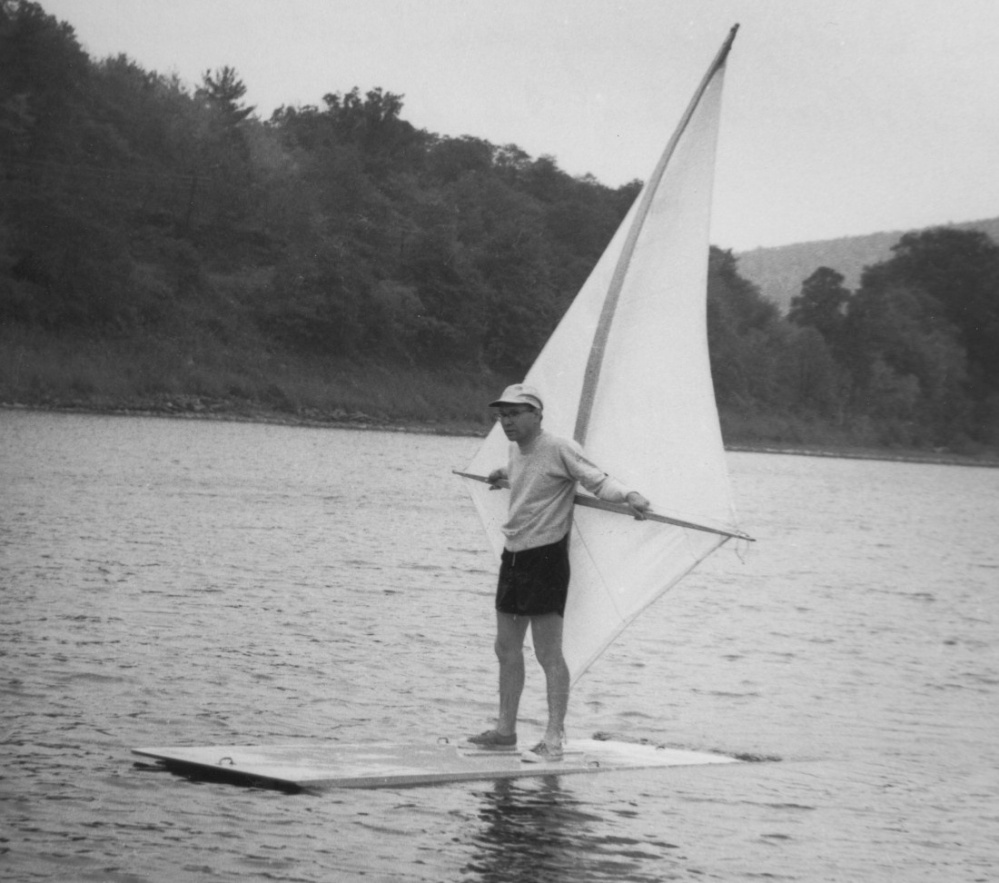It was surfing that led S. Newman Darby, a 20-something commercial artist and sign painter who had tinkered with sailboats, rowboats and other small watercraft since he was a child, to try to fly through the water with his hands on a sail.
The waves near his home in eastern Pennsylvania, on big lakes and even in the Atlantic Ocean, were considered too small for traditional surfing. So in the late 1940s Darby began swimming out into the water with a large canoe paddle, hopping onto his surfboard in the face of a brisk wind and holding the paddle aloft – both to pick up speed and, by adjusting the direction of its flat-faced blade, to steer himself toward shore.
On sailing trips with his girlfriend, a canoe racer whom he soon married, Darby refined the idea that in 1964 became the sailboard: a rudderless vessel that crosses elements of sailing and surfing and is credited with launching the sport of windsurfing.
Darby, who died Dec. 3 at 88 at his home in St. Johns, Florida, crucially received no patent for his design, and for many years was overlooked or altogether unknown to windsurfing enthusiasts and historians. Until the mid-1990s, the sport was associated mainly with two Californians, Jim Drake and Hoyle Schweitzer, who in 1970 were granted a patent for a similar design that they called the Skate, the Baja Board and then, fatefully, the Windsurfer.
Darby’s design, honed by him and Naomi Albrecht on a small lake near his hometown of Wilkes-Barre, featured a kite-shaped sail atop a modified scow – a quick-moving, flat-bottomed sailing vessel with wide, square ends. To connect sail and scow, Darby fashioned an 18-inch length of nylon rope into a universal joint, allowing him to turn the sail in any direction and ride confidently in high winds. Albrecht, whom he married later in 1964, crafted the first sails.
Though difficult to master, the craft proved easy enough to learn that by Christmas Darby decided to sell fiberglass sailboards commercially, at $295 each, with business help from his two brothers.
While continuing his sign-painting business, Darby gave some of the boards away on the television game show “The Price Is Right” and placed ads in the New York Times and in Popular Science magazine, where he wrote an accompanying four-page article complete with schematics illustrating the board’s construction.
“Sailboarding is sailing with a difference,” he wrote in the 1965 story. “You get all the fun of handling a fast, responsive boat. You can have the fun of spills without the work of righting and bailing out. And you can learn to master a type of maneuvering that’s been dead since the age of the picturesque square riggers.”
Darby sought a patent for his design, but – believing that his Popular Science story would demonstrate his claim to the universal joint and other details of the craft – gave up when the legal cost proved too high.
At the same time, board sales proved sluggish. In the next several years, Darby and his business, Darby Industries Inc., sold only about 80 of the boards before turning to the manufacture of truckhoes, backhoes and outdoor furnaces.
Hundreds of thousands of sailboards have since been sold, many of them through Drake and Schweitzer’s company Windsurfing International. When Darby and his wife recognized elements of their original design in the Windsurfer model, they contacted the U.S. Patent and Trademark Office. (Drake and Schweitzer said they had not read Darby’s original article; in one interview, Drake referred to himself as merely the sailboard’s “reinventor.”) The office told them they could invalidate the Windsurfer patent by writing formal letters to the agency and to Windsurfing International.
“I actually went home, wrote the two letters and had them in the envelopes,” Naomi Darby told American Windsurfer magazine in 1997. Lawyers told her and Darby not to send the letters, fearing an expensive legal fight.
Darby’s focus returned to painting signs. His name surfaced in the 1980s as part of a patent fight initiated by Windsurfer International against a competitor, but Darby sought little compensation for his invention, his daughter Wendy Darby Brown said.
Send questions/comments to the editors.



Success. Please wait for the page to reload. If the page does not reload within 5 seconds, please refresh the page.
Enter your email and password to access comments.
Hi, to comment on stories you must . This profile is in addition to your subscription and website login.
Already have a commenting profile? .
Invalid username/password.
Please check your email to confirm and complete your registration.
Only subscribers are eligible to post comments. Please subscribe or login first for digital access. Here’s why.
Use the form below to reset your password. When you've submitted your account email, we will send an email with a reset code.